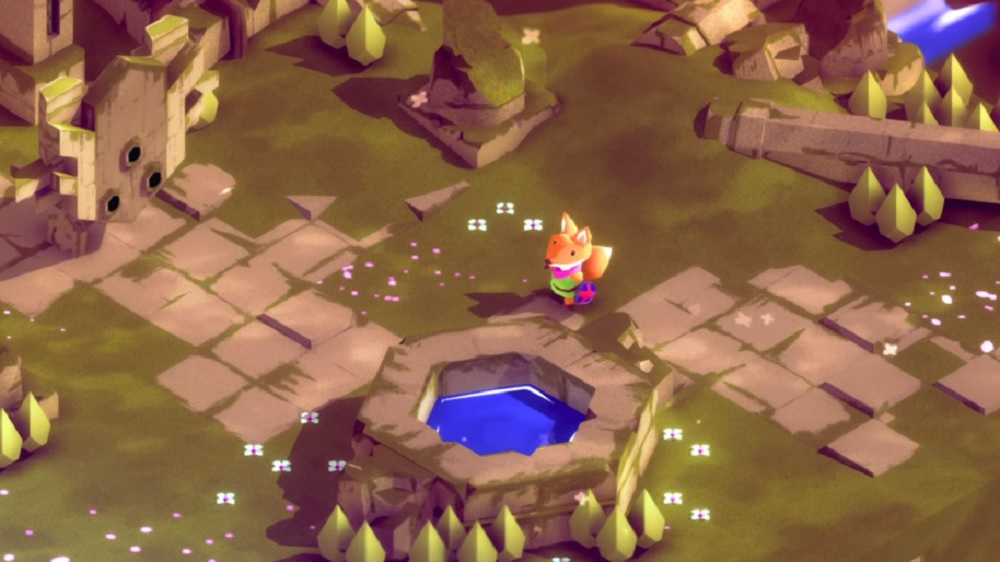The art of getting lost
Microsoft had a stellar E3 presentation this year, but there wasn’t too much to keep me interested. I’m not really into most of the Xbox-exclusive franchises and the vague promise of “things to come” didn’t hold much clout for me. In the random indie stream of games, though, Microsoft gave highlight to Tunic from Finji and it immediately caught my attention.
From the quick trailer, Tunic looked reminiscent of old-school Zelda. It featured a fox instead of a weird elf character and the art style looked positively gorgeous. It was like a fuzzy, angular world made of felt and harsh geometry. It was certainly eye-catching and hard to forget.
Walking around RTX this weekend, I honestly didn’t expect to see the game. I took one look at the banner and jumped at the chance to get my hands on the game. I met with Andrew Shouldice, lead designer for Tunic, and he quickly got me seated to play. Giving me basically nothing to go on, I walked in with assumptions of how Tunic might play and was off.

The Zelda comparison is incredibly apt as Tunic feels exactly like the original NES classic. You show up in some distant land and are given control with no tutorials or interruptions. There might be some plot going on, but this early demo didn’t shovel exposition in your face. This is just you, a plucky little fox, traveling alone and trying to piece things together as you go.
One of the first things I noticed was how pointy the grass looked. This is what I meant by angular world, as Tunic has a very defined aesthetic. Once you get acquainted to the particular style, it jells together quite well. Tunic looks very much like playing with stuffed animals; I kind of love it.
As for the gameplay, everything takes place from an isometric perspective. The original Zelda (and subsequent 2D incarnations) are all simply top down, so it took a little adjustment to get into a flow. For the most part, the isometric view doesn’t really impede you, but sometimes your character will get stuck behind giant trees and it can be hard to spot him with how zoomed-in the camera is. At least movement is handled with the analogue stick, so you aren’t locked into only eight directions.
Unlike the NES classic, Tunic has multiple layers to the level geometry. There are stairs and ladders you can climb and these will take you higher into the game world. For some reason, though, you will always be locked to the ground you are on. There are no pitfalls or bottomless pits and you aren’t allowed to jump down from any heights. It didn’t hinder my enjoyment of the game, but it does feel like a missed opportunity to not better utilize the 3D space that the developer has crafted.

At least as far as weapons and items go, the classic N64 style of Zelda is replicated well. You can equip anything to the X, Y and B buttons on your controller and A simply acts as a way to interact with various objects in the game world. With that all squared away, you’re really just walking into dungeons and seeing how far you can go until you hit a roadblock. From there, you’ll either need to double back to a different path or find an item that can help you progress.
Combat inherits the lock-on ability from the N64 Zelda titles. While it isn’t really necessary, it does help with targeting specific foes when you get surrounded. That being said, you aren’t looking at combo strings or complex maneuvers; this is a simple game that puts more emphasis on exploration than battles.
The demo saw me enter “Level 3,” which I thought was a mistake at first. While Andrew Shouldice couldn’t give me any specifics, it seems like Tunic will follow the same non-linear progression that allowed for sequence breaking in classic Zelda titles. You’ll be able to enter levels at your discretion and are left to figure out how to proceed. Curiously, though, the sword I needed to cut through trees was in level 3, so I was forced to proceed there first.
Enemies are typical of the fantasy genre. You’ll be battling ogres, spiders, and goblins. The final boss of the area I entered was the same one from the E3 trailer: a giant statue-like guy. I’m guessing different levels will have different enemy themes, though I’m not quite sure how spiders fit in with an Aztec-like stone boss. That being said, everyone hits like a truck and I nearly died a few times. The final boss did best me and the demo immediately ended as I perished.

There isn’t much more to say as Tunic is still early in development. I asked about a potential release date and some of the other members of Finji didn’t have any specifics. While they’ve been working on the game for a few years now, it is still at least another year away from release. As for platforms, the game will be heading to Xbox One and PC via Steam.
I’m certainly eager to see more of it. People applauded Breath of the Wild for going back to Zelda’s roots, but Tunic feels more like a replication of what Nintendo started over 30 years ago. It may not win over fans that cut their teeth on Zelda’s latest adventure, but it is sure to please older fans that have been aching for a return to the series’ roots.





Published: Aug 4, 2018 11:00 am